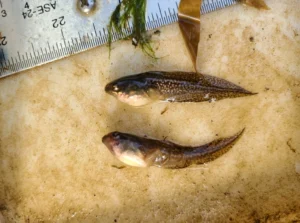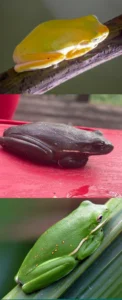American green tree frogs (Hyla cinerea) are small, smooth-skinned frogs found in the central and southeastern United States, from eastern Virginia down to Florida and as far west as Texas. Their coloration varies from grayish-green to dark green to bright green. Many have white, yellow, or sometimes iridescent stripes along each side of the body, with strong black borders.
Green tree frogs can change color depending on the temperature, light, activity, or the color of their surroundings. A green tree frog may appear brown, to blend in with a tree trunk, or green when resting on foliage. Generally, green tree frogs tend to become darker when their environment is cold or dark.
That said, it’s important to note that green tree frogs don’t change color as fast as a chameleon. However, the color change is still fast enough to keep these frogs camouflaged and hidden from predators.
Green Tree Frog Tadpoles Have Inconsistent Coloring
Green tree frogs hatch from eggs and start their lives as tiny tadpoles that live entirely in the water. Tadpoles are very different from adult gray tree frogs. This is because they are highly adapted for their fully aquatic life.
They have gills and a flat paddle-like tail fin to help them move in the water.
Green tree frog tadpoles have continuous ontogenetic color changes until they reach stages 25 or 26 of their development. At this point, the tadpoles have a green body and a yellow underside.

The tail may have distinct yellow orbitonasal stripes, and dark mottling or reticulations.
Tadpoles Turn Into Froglets
After about 1- 2 months, the tadpoles will go through a process known as metamorphosis, in which they will transform into juvenile frogs.
During metamorphosis, the thyroid gland secretes a growth hormone called thyroxine.
This hormone triggers the tadpoles to:
- Lose the gills, and develop lungs for breathing air
- Absorb the tail into the body
- Grow strong legs for moving on land
- Remodel other organs to form an adult frog
Once this process is complete, tiny green tree frogs called “froglets” or “metamorphs”, will leave the water and live on land.
Over time, these metamorphs will grow and mature into adult green tree frogs.
Adult Green Tree Frogs Have Varied Coloration
Adult green tree frogs range from 1¼ to 2½ inches long and have smooth skin.
They have a varied body coloration which can range from bright yellow-green, to reddish-brown. Their dorsum frequently has small golden spots which overlay the green color. The underside has a white to cream coloration.

Green tree frogs also have a white, yellow, or sometimes iridescent stripe running from the jaw, along each side of the body. The stripe can be longer on one side of its body than it is on the other.
In addition, the length of these stripes varies among some populations and, may be absent in some individuals.
Male green tree frogs are generally darker than females. However, frogs of both sexes have the ability to change color depending on activities and the environment.
A green tree frog may be a vivid shade of lime green when resting on green foliage, but when resting on a tree trunk, it may change into a shade of brown within a span of a few minutes—blending in perfectly with the background.
These frogs can change color dramatically, though at a slower rate than a chameleon.
Besides substrate color, other reasons a green tree frog may change color include:
- Temperature – They tend to become darker/duller when it is cold
- Time of day/light – They tend to become darker at night and lighter in color in warm sunny areas
- Time of year – They tend to become yellower during the breeding season (not always)
How Do Green Tree Frogs Change Color?
Coloration in animals is produced by reflection and scattering of light by cells and tissues and by absorption of light by chemical pigments within cells of the skin.
In ectotherms such as frogs, cells containing pigments are called chromatophores and are largely responsible for generating skin color.
In frogs, there are three main types of chromatophores:
- Xanthophores, which contain yellow-red pigments
- Iridophores contain colorless stacks of crystals or platelets that reflect and scatter light to generate hues such as blue and white
- Melanophores, which contain black melanin pigment
The melanophores play an important role in color change.
They are large, star-like cells with long “arms” that extend towards the skin’s surface.
Color change occurs due to the movement of “packets” of melanin pigment (melanosomes) within the melanophores.
When melanin pigment is clustered within the center of the cell, the skin appears very pale – and when it is dispersed through the arms of the melanophores towards the skin’s surface, the frog appears dark.
Because the arms of the melanophores extend between and over the other types of chromatophores (generating different colors), varying the degree of dispersion of the melanin can hide or reveal those chromatophores, changing the animal’s color.
Color change may happen due to various “triggers” including temperature or light. However, most importantly, green tree frogs change color in response to their surroundings.
They need to observe their surroundings so that they know what color to change to. Information about their surroundings is then processed by the brain, and the brain sends signals to chromatophores.
Dead Green Tree Frogs Are Often Green
Dead green tree frogs often have a green body coloration. This green coloration is also observed in green tree frogs in unnatural surroundings, such as in people’s homes, or resting on man-made objects.
Since green tree frogs change their skin color using neural impulses, when one of these frogs dies, it stops sending those signals and turns to its ‘natural’ color, which is predominantly green.
Common Questions About Gray Tree Frog Coloration
Can green tree frogs change color? Green tree frogs can change color depending on the temperature, light, or the
color of their surroundings. They tend to be a shade of brown when resting on a brown tree trunk, and lime green to dark green when resting on foliage. These frogs also tend to become darker when their environment is cold or dark
Conclusion
Despite their name, not all green tree frogs are actually green. They vary in coloration from can range from bright yellow-green, to reddish-brow
However, they can change their color dramatically in a matter of minutes, based on various “triggers” including temperature,
light, and the color of their surroundings.
In general, male green tree frogs are generally darker than females.
Sources:
King, R. B., Hauff, S., & Phillips, J. B. (1994). Physiological Color Change in the Green Treefrog: Responses to Background Brightness and Temperature. Copeia, 1994(2), 422–432. https://doi.org/10.2307/1446990
Amy L. Wolfberg (2003). Green Tree Frogs Changing Color. CALIFORNIA STATE SCIENCE FAIR (PDF),
Devi Stuart-Fox (2013). How do chameleons and other creatures change color? University of Melbourne.
AmphibiaWeb.Hyla cinerea North American Green Treefrog, Green Treefrog. University of California, Berkeley, CA, USA.
Nichols, M. 2008. “Hyla cinerea”, Animal Diversity Web.


